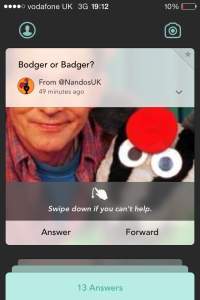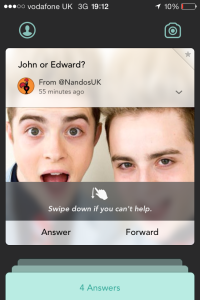
Jelly – why this new platform will be relevant for marketers
This week’s social media platform launch is Jelly; a text-plus-image-based question and answer platform from Twitter co-founder Biz Stone which, at first glance, seems like a cross between Quora and Thumb (remember that one?). The idea is simple – stick up a photo of whatever it is you’re talking about, scrawl on it in a Snapchat-esque way to indicate the relevant area, and then ask a question in supporting, overlaid text. Second-degree contacts from your Facebook and Twitter profiles (i.e. friends-of-friends) can answer, and you can reward their answer with a ‘Thank-You’ card.
The list of questions I’ve answered so far is diverse, as people experiment with the platform and what role it’s going to fill for them, and I’ve got to be honest; I found it quite addictive. It also allows you to forward particularly interesting questions to others outside of the app, though with your network already including second-degree contacts, how useful this will be remains to be seen…
But is there a way Jelly can be used by brands? FreshMinds was quick off the mark, suggesting that there are clear benefits from a market research perspective from the potentially quick turnaround of feedback, but I think there are a few other potentially huge opportunities with Jelly.
Because of the second-degree contacts angle, there is an obvious benefit to broadcasting, for instance, new product info, to people who share some of the same interests with those who already follow your brand. Three or four years ago, the next big thing was supposedly ‘social search’, but Jelly might be the first app that actually considers this, in streamlining your audience for you, to those who are incrementally likely to want to see it.
Following on from this, it makes sense to use Jelly as an outreach tool – if you want to target people who share interests with your fans, what better way than by getting your content in front of their first- and second-degree contacts? This could prove valuable for, for instance, short-term deals for interested groups (“Want first play of the new slimline PS4? Find it here” + ringed picture of map).
Once the ability to personalise the ‘Thank-You’ card arrives (as it surely must), there will be opportunities for offer codes and personalised promotions for those who answer a brand’s question correctly.
Jelly’s second-degree contacts base could open up a different question, however, in accessing others’ networks, which I can see some users taking issue with. If it’s now possible to talk to anyone (with the app) who follows one of my followers, and I’m followed by an influential blogger with a painstakingly-built, highly-protected network, what’s to stop me from bypassing the blogger and talking to their network directly? If Rosie of The Londoner blog follows me, and I start posting great pictures of burgers to Jelly, these will be seen by her followers on the platform as well… Ok, so I won’t have the same influence as she does, but if the content is on-theme and of interest to this group, I can see there’s potential for a souring of relations there. Whether or not this actually happens is yet to be seen, but just one thing to bear in mind, if you work with influential, protective blogger networks.
What do you reckon? What did I miss, in my 40-minute exploration of the app and some speculative uses?
Key takeaways:
- Jelly is an image + text question and answer app for your phone
- Uses extended reach of your existing social networks
- Opportunity to reach a more targeted, friends-of-friends audience
- Opportunities for limited-edition content
- Potential for personalised promotions in the future
- Must consider whether you’re bypassing bloggers to get to their networks
UPDATE 15/01/14: The official Jelly blog has today provided a few helpful examples of how people are using the platform to help each other, as was the developers’ intention. Elsewhere on the web (and on Jelly itself) people seem to be using the app mostly for asking nonsense questions and making bad puns, while Lee Stacey has been commenting and asking exclusively about feta cheese. This, for the moment, is the status quo, while users try to nail down the core uses for Jelly. We’ll keep you posted. In the meantime, here are a few examples from Nando’s, whose approach is pretty indicative of the type of content I’ve seen from brands in the first few days of the platform’s launch…





Leave A Comment